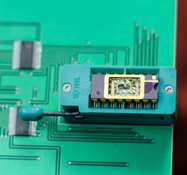Carbon nanotube creates prototype lab-on-a-chip for physicians
A New Jersey Institute of Technology professor known for his cutting-edge work with carbon nanotubes is overseeing the making of a prototype lab-on-a-chip that would someday enable a physician to detect disease or virus from just one drop of liquid, including blood. Professors Reginald Farrow and Alokik Kanwal, his former postdoctoral fellow, have created a carbon nanotube-based device to noninvasively and quickly detect mobile single cells with the potential to maintain a high degree of spatial resolution.
NJIT researchers evaluated three different types of cells using three different electrical probes. "It was an exploratory study and we don't want to say that we have a signature," Farrow said. "What we do say here is that these cells differ based on electrical properties. Establishing a signature, however, will take time. We do know that the distribution of electrical charges in a healthy cell changes markedly when it becomes sick."

NJIT researchers have created this prototype lab-on-a-chip that may someday enable a physician to detect disease or virus from just one drop of liquid. (Photo: NJIT.)
The device uses standard CMOS technologies for fabrication, allowing it to be easily scalable down to a few nanometers. Nanotubes are deposited using electrophoresis after fabrication in order to maintain CMOS compatibility. The devices are spaced by 6 μm, which is the same size or smaller than a single cell. To demonstrate its capability to detect cells, the researchers performed impedance spectroscopy on mobile human embryonic kidney (HEK) cells, neurons from mice, and yeast cells. Measurements were performed with and without cells and with and without nanotubes. Nanotubes were found to be crucial to successfully detecting the presence of cells.
The carbon nanotubes are very strong, electrically conductive structures a single nanometer in diameter, or approximately the size of 10 hydrogen atoms in a row. Farrow's breakthrough is a controlled method for firmly bonding one of these submicroscopic crystalline electrical wires to a specific location on a substrate. His method also introduces the option of simultaneously bonding an array of millions of nanotubes and efficiently manufacturing many devices at the same time. For more information, go to www.njit.edu/news/2013/2013-218.php.